Lecture 13: How to take a hint, an Integration Case Study
1/22
There's no tags or description
Looks like no tags are added yet.
Name | Mastery | Learn | Test | Matching | Spaced |
|---|
No study sessions yet.
23 Terms
What is premise monotonicity?
adding evidence strengthens an inductive argument.
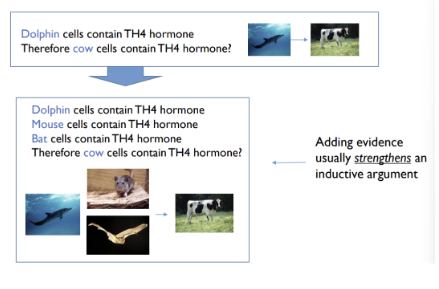
What is the premise of non-monotonicity?
Sometimes adding evidence weakens an arguments.
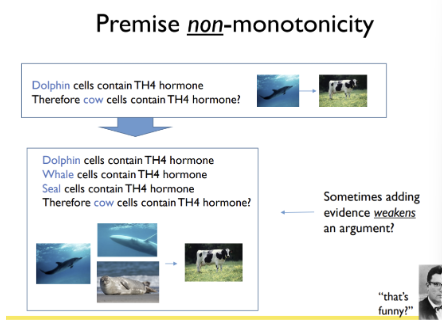
What does ‘similarity shapes reasoning" mean?
If the premises lists objects that more more similar to the conclusion it is more likely that monotonicity occurs
If the premise lists objects that are more dissimilar to the conclusion it is more likely that non-monotonicity.
What does ‘similarity directs attention to a particular category’ mean?
It demonstrates that if the premises are more similar to the conclusion, the more likely our attention is directed to the categories surrounding premises and conclusions. aka . sea creatures vs. animals generally.
This makes it more or less likely that we accept the final conclusion.
What are the possible origins of data?
Information from the world → The world doesn’t care what you believe, and it doesn’t try to influence you: it’s just a big dumb rock – creates more RANDOM DATA
Information from the people → Other humans do care what you believe, and they do try to shape your beliefs by choosing the right words (associated with theory of the mind). – creates more RELEVANT DATA ;
What is the theory of the mind?
We have intuitive theories about the workings of each other’s minds, so we can select relevant information that drives attention to the right answer.
Therefore we chose the categories of premises that are more similar to our targeted conclusions compared to categories which may not support our conclusions.
Explain the dependent variable in the reasoning task experiment?
In the experiment, participants are asked to rate an inductive argument with a single permanent, a second item is added and participants are asked to revise their estimate. The dependent variable becomes the difference between the rating of premise monotonicity vs. premise non-monotonicity.
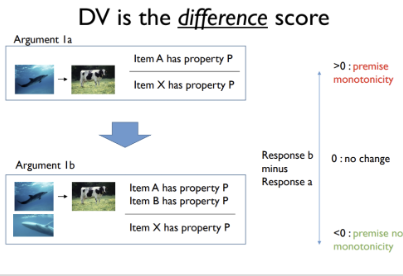

Explain the hypothesis in the reasoning task experiment?
When an indifferent world generates random data, the similarity between premise items will be deemed irrelevant, and people will revert to premise monotonicity
When a helpful human makes an argument, the similarity between premise items will be deemed relevant, and the premise non-monotonicity effect will appear
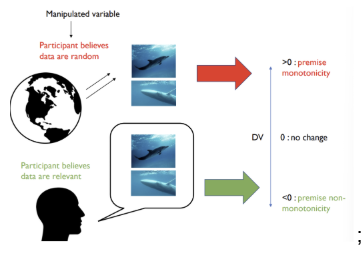
Explain the problem of the fact that the experiment is designed by an experimenter?
essentially demand characteristics – the participant knows that technically all premises occur as a result of a human decision, meaning that technically you cannot test the non-mononicity vs. mononicity of a premise
They solved this problem, by specifying the premises occurs either as a result of a
Relevant - Previous participant
Neutral - no data given about source
Random - chosen at random from a database.
Explain the ‘Cover Story’ manipulation?
the second premise is a relevant story, a neutral story or a random story -
Relevant story - It is a hint from a previous participant
Neutral story - Don’t tell them where it comes from
Random story - It is chosen at random from a database
Explain the ‘experience’ manipulation?
Split participants into people who have been told that the examples are either
Relevant data - Previous examples have been helpful
Random data - Previous examples have been stupid
Explain the flow of the experiment?
People are told the 1st premise, then when the 2nd premise appears, we remind participants that the 2nd premise is random, a hint or neutral
In the first set of trials, the 1st, 2nd and 4th arguments are filler items designed to highlight the relevance and randomness of the premises – this is the experience manipulation.

Technically this is an incomplete 2 x 3 design
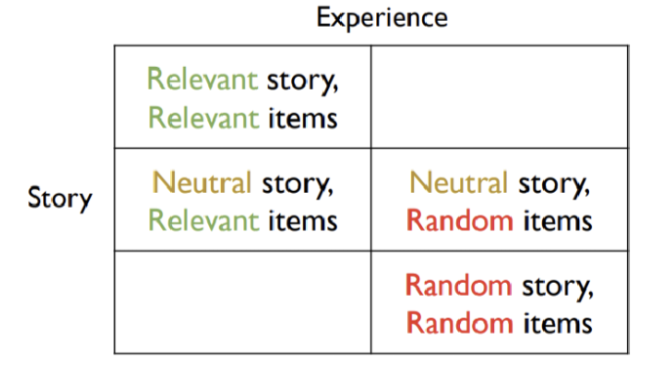
Why should the experiment exist as an incomplete 2 x 3 design?
as if random item/story and relevant story/item exists together it would not make sense?
Additionally we don’t have a neutral items condition - this because it doesn’t make sense as well, you would just be repeating the premise twice.
How would you measure the effect?
We are interested in the difference scores between these target arguments.

What do we expect if our hypothesis is right?
Strength of argument in target will be dependent on the random vs. relevant experience – With random decreasing the strength of the argument – And relevant increasing the strength of the argument
We should have a strengthening of the argument for all controls
Describe the premise of the control item?
For control items, the second premise was similar to the first presmise and dht conclusion
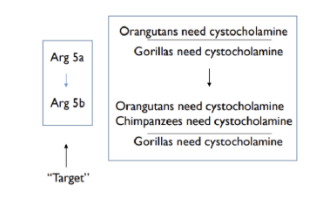
Expect strengthened arguments in both conditions (database, hint or neutral)
Describe the premises of the target items?

For target items the second premise was similar to the first premise item but not the conclusion
If the similarity is relevant then the extra evidence will weaken the argument, it is irrelevant then the extra evidence will not change in the rating
What do we expect if our hypothesis is right?
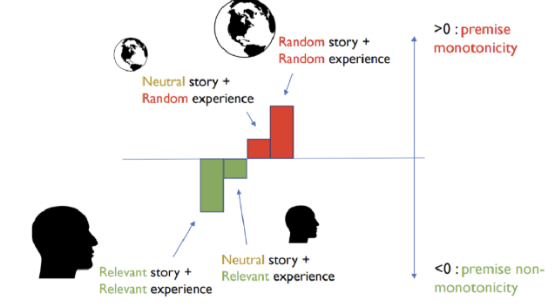
Strength of argument in target will be dependent on the random vs. relevant experience – With random decreasing the strength of the argument – And relevant increasing the strength of the argument
We should have a strengthening of the argument for all controls
What should we expect if the data is wrong?
There should be no differences in the independent variable.
What were the results?
The target arguments are systematically influenced in the expected pattern.
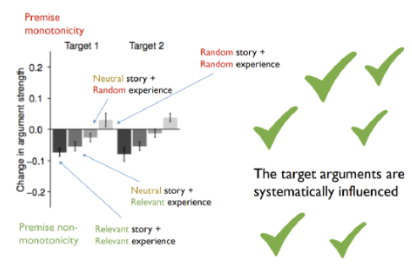
What are the limitations of the experiment?
Sample not representative - participant recruited online, diverse in age and gender but narrow in nationality
Limited range of arguments - a fixed set of six arguments were used, all of which were about animals – might present a problem as people have different sets of knowledge around animals
Limited range of phenomena - only look at premise monotonicity effect
What is the reason that we build models?
A single task often requires psychologists to think about several different aspects of human cognition.
Using psychological theories to guide experimental designs yields insight into how cognition works.
Human reasoning (and cognition generally) can be complicated, which is one of the reasons we build models.
What does cognition say about the brain vs. neuroscience ?
The “computational” approach – The brain is an information processing machine – Modelling of subprocesses
Fundamental properties of neurons and their circuits